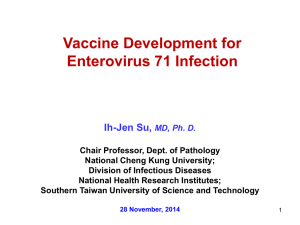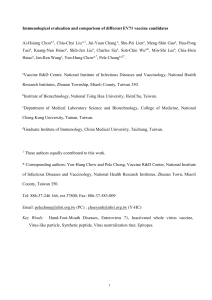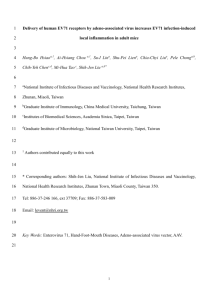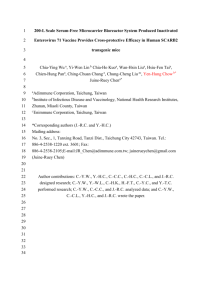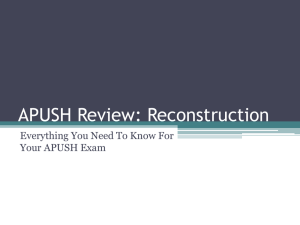MattSURIPposter - Penn State University
advertisement
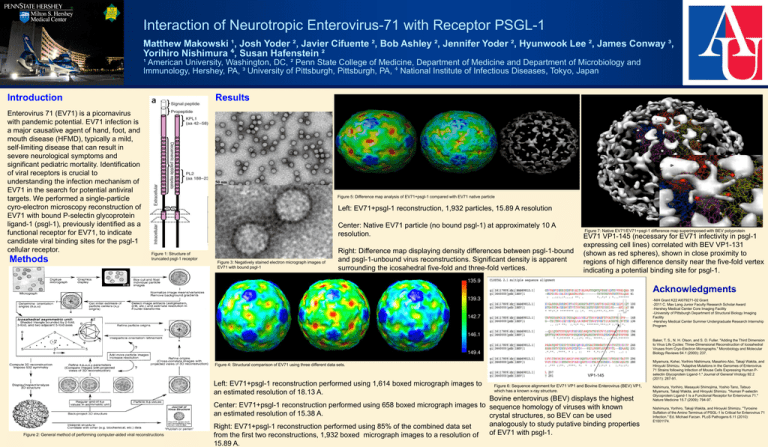
Interaction of Neurotropic Enterovirus-71 with Receptor PSGL-1 Matthew Makowski ¹, Josh Yoder ², Javier Cifuente ², Bob Ashley ², Jennifer Yoder ², Hyunwook Lee ², James Conway ³, Yorihiro Nishimura ⁴, Susan Hafenstein ² ¹ American University, Washington, DC, ² Penn State College of Medicine, Department of Medicine and Department of Microbiology and Immunology, Hershey, PA, ³ University of Pittsburgh, Pittsburgh, PA, ⁴ National Institute of Infectious Diseases, Tokyo, Japan Results Introduction Enterovirus 71 (EV71) is a picornavirus with pandemic potential. EV71 infection is a major causative agent of hand, foot, and mouth disease (HFMD), typically a mild, self-limiting disease that can result in severe neurological symptoms and significant pediatric mortality. Identification of viral receptors is crucial to understanding the infection mechanism of EV71 in the search for potential antiviral targets. We performed a single-particle cyro-electron microscopy reconstruction of EV71 with bound P-selectin glycoprotein ligand-1 (psgl-1), previously identified as a functional receptor for EV71, to indicate candidate viral binding sites for the psgl-1 cellular receptor. Methods Figure 5: Difference map analysis of EV71+psgl-1 compared with EV71 native particle Left: EV71+psgl-1 reconstruction, 1,932 particles, 15.89 A resolution Center: Native EV71 particle (no bound psgl-1) at approximately 10 A resolution. Figure 1: Structure of truncated psgl-1 receptor Figure 3: Negatively stained electron micrograph images of EV71 with bound psgl-1 Right: Difference map displaying density differences between psgl-1-bound and psgl-1-unbound virus reconstructions. Significant density is apparent surrounding the icosahedral five-fold and three-fold vertices. Figure 7: Native EV71/EV71+psgl-1 difference map superimposed with BEV polyprotein EV71 VP1-145 (necessary for EV71 infectivity in psgl-1 expressing cell lines) correlated with BEV VP1-131 (shown as red spheres), shown in close proximity to regions of high difference density near the five-fold vertex indicating a potential binding site for psgl-1. Acknowledgments -NIH Grant K22 AI079271-02 Grant -2011 C. Max Lang Junior Faculty Research Scholar Award -Hershey Medical Center Core Imaging Facility -University of Pittsburgh Department of Structural Biology Imaging Facility -Hershey Medical Center Summer Undergraduate Research Internship Program Baker, T. S., N. H. Olson, and S. D. Fuller. "Adding the Third Dimension to Virus Life Cycles: Three-Dimensional Reconstruction of Icosahedral Viruses from Cryo-Electron Micrographs." Microbiology and Molecular Biology Reviews 64.1 (2000): 237. Figure 4: Structural comparison of EV71 using three different data sets. VP1-145 Left: EV71+psgl-1 reconstruction performed using 1,614 boxed micrograph images to an estimated resolution of 18.13 A. Figure 2: General method of performing computer-aided viral reconstructions Figure 6: Sequence alignment for EV71 VP1 and Bovine Enterovirus (BEV) VP1, which has a known x-ray structure. Bovine enterovirus (BEV) displays the highest Center: EV71+psgl-1 reconstruction performed using 658 boxed micrograph images to sequence homology of viruses with known an estimated resolution of 15.38 A. crystal structures, so BEV can be used analogously to study putative binding properties Right: EV71+psgl-1 reconstruction performed using 85% of the combined data set of EV71 with psgl-1. from the first two reconstructions, 1,932 boxed micrograph images to a resolution of 15.89 A. Miyamura, Kohei, Yorihiro Nishimura, Masahiro Abo, Takaji Wakita, and Hiroyuki Shimizu. "Adaptive Mutations in the Genomes of Enterovirus 71 Strains following Infection of Mouse Cells Expressing Human Pselectin Glycoprotein Ligand-1." Journal of General Virology 92.2 (2011): 287-91. Nishimura, Yorihiro, Masayuki Shimojima, Yoshio Tano, Tatsuo Miyamura, Takaji Wakita, and Hiroyuki Shimizu. "Human P-selectin Glycoprotein Ligand-1 Is a Functional Receptor for Enterovirus 71." Nature Medicine 15.7 (2009): 794-97. Nishimura, Yorihiro, Takaji Wakita, and Hiroyuki Shimizu. "Tyrosine Sulfation of the Amino Terminus of PSGL-1 Is Critical for Enterovirus 71 Infection." Ed. Michael Farzan. PLoS Pathogens 6.11 (2010): E1001174.
